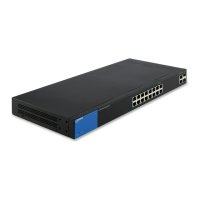101
4.
Enter the parameters.
•
Region Name—Define an MSTP region name.
•
Revision—Define an unsigned 16-bit number that identifies the revision of the
current MST configuration. The field range is from 0 to 65535.
•
Maximum Hops—Set the total number of hops that occur in a specific region
before the BPDU is discarded. Once the BPDU is discarded, the port information is
aged out. The field range is from 1 to 40.
•
IST Master (display only)—Displays the region’s master.
5.
Click Apply. The MSTP properties are defined, and the Running Configuration file is
updated.
To edit an MSTP instance:
1.
Click Configuration > Spanning Tree Management> MSTP Properties.
2.
Select the MST instance from the MST Instance Table and click Edit.
3.
Enter the parameters.
•
MST Instance ID—Select an MST instance to be displayed and defined.
•
Bridge Priority—Set the priority of this bridge for the selected MST instance.
•
Action—Select Add VLAN or Remove VLAN.
•
VLANs—Displays the VLANs mapped to the selected instance. The default
mapping is that all VLANs are mapped to the common and internal spanning tree
(CIST) instance 0).
4.
Click Apply. The MSTP properties are defined, and the Running Configuration file is
updated.

